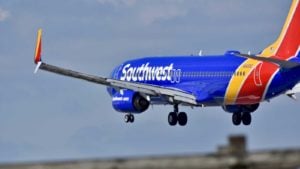For dividend investors, one of the worst things about the $2 trillion coronavirus stimulus package is the conditions placed on companies that accept government help. That’s why it’s interesting that Southwest Airlines (NYSE:LUV) appears to be waffling on accepting stimulus money, with the eye on keeping its dividend intact. It certainly makes LUV stock worth a look.

No doubt, Southwest and other airlines are losing big these days. I suppose the notion of a sunny vacation loses its allure if you’ve got travel in close quarters in a flying petri dish seething with coronavirus germs.
But despite the challenges, LUV stock appears to be one of the best positioned to withstand this downturn.
Southwest Stock at a Glance
Southwest stock is trading down 32% so far in 2020, about 8% worse than losses in the Dow Jones Industrial Average. The stock price is seeing a slight rebound in recent days as Congress debated, then approved, its stimulus package that includes $50 billion in assistance for the airline industry.
Southwest is due to report earnings in late April, when it’s expected to have earnings of 49 cents per share. Not surprisingly, that would be down sharply from a year ago when it reported earnings 0f 70 cents per share.
Even so, there’s fair reason to hope that LUV will manage to beat expectations. Southwest topped analysts’ expectations for eight consecutive earnings reports, and it hasn’t been since April 2017 that it recorded a narrow miss.
In January, Southwest reported Q4 2019 earnings of $1.16 per share on revenues of $5.73 billion. But that seems like eons ago – back in January, the biggest headwind against Southwest was the continued grounding of the Boeing (NYSE:BA) 737 Max aircraft.
The coronavirus is a whole new ballgame for LUV stock.
Southwest Stock and the Coronavirus
Southwest canceled 1,500 daily flights, up from a planned 1,000 cuts announced just a few days before. That’s a 40% reduction in daily flights.
That’s how fast the COVID-19 pandemic is changing things for Southwest.
“The pandemic and the government response have sunk passenger levels and future bookings to unimaginable lows across the industry,” Southwest CEO Gary Kelly told employees in a videotaped message.
The company has also ended beverage and snack service on its flights – cutting an expense while at the same time tipping a cap toward the need to reduce contact between passengers and crew members amid the pandemic.
In the video, Kelly describes Southwest flights that are less than 20% full and C-suite efforts to slash costs and find “billions of dollars in immediate liquidity.”
“We find ourselves in the great challenge in our generation, a challenge of a magnitude not seen in many generations,” he said. “Dynamics surrounding the COVID-19 pandemic are changing day by day, if not hour by hour.”
Southwest officials lobbied Washington for the stimulus package, but even now there’s no guarantee that it’s going to accept.
The government money – in the form of $25 billion in loans and $25 billion in grants comes with a few conditions. Airlines must promise that employment levels remain stable, agree to limits on executive pay, and accept restrictions on dividends and stock buybacks.
But Southwest recently offered voluntary leave with partial pay to its flight attendants, raising concerns among its unions that Southwest is going to forgo the stimulus cash after all.
“The company created this emergency time off program blindly, quickly, and with complete disregard for what is being negotiated and approved in Congress,” the Transport Workers Union Local 556 said in a letter to its members. “Southwest Airlines also claims they ‘retain the right to reject government funding and the strings that come with it.’”
In a video message to employees last week, Kelly told workers that the stimulus package is “another option” beyond the company’s access to loans and credit lines.
The Bright Spots for Southwest Stock
It’s not all doom and gloom for LUV stock.
For one thing, Southwest is in better financial shape than some of its competitors. Two analysts upgraded the shares on March 23 to the equivalent of “buy” ratings.
Southwest is “the highest quality airline in the group with a very conservative balance sheet and low earnings volatility,” said BofA Securities analyst Andrew Didora in a recent note. “As such, we believe it is best positioned to weather the current coronavirus outbreak given its significant liquidity and low net leverage entering the year.”
Southwest had a cash stockpile of $4.1 billion at the end of 2019, and after drawing down $1 billion available in revolving credit and securing a $1 billion short-term loan, it had $6.2 billion available to handle any shortfalls. That’s a lot of wiggle room that gives LUV a bit of extra security.
Then there’s the dividend. Southwest increased its dividend every year for the last eight years, currently paying out 72 cents per share for a 1.9% dividend yield. That’s a respectable yield for a company that’s facing more than its share of challenges.
But even more important, LUV’s dividend has been one that you can count on. Southwest paid a dividend for 77 consecutive quarters and has a three-year annualized dividend growth rate of 5.3%.
The Bottom Line on LUV Stock
In an extremely challenging economy, it’s important to look for stocks that you can count on to come through when it counts.
I like that Southwest isn’t jumping in line to get its hands on government money. I like that it has roughly 20% of its market value in cash to supplement it through the coronavirus downturn. And I like when companies make it a priority to offer and protect its dividend.
Airline stocks are too risky for me right now to take a new position. But if Southwest can get through this and still be a dividend stock, it will be my new favorite airline carrier.
Patrick Sanders is a freelance writer and editor in Maryland, and from 2015 to 2019 was head of the investment advice section at U.S. News & World Report. Follow him on Twitter at @1patricksanders. As of this writing, he did not hold a position in any of the aforementioned securities.
